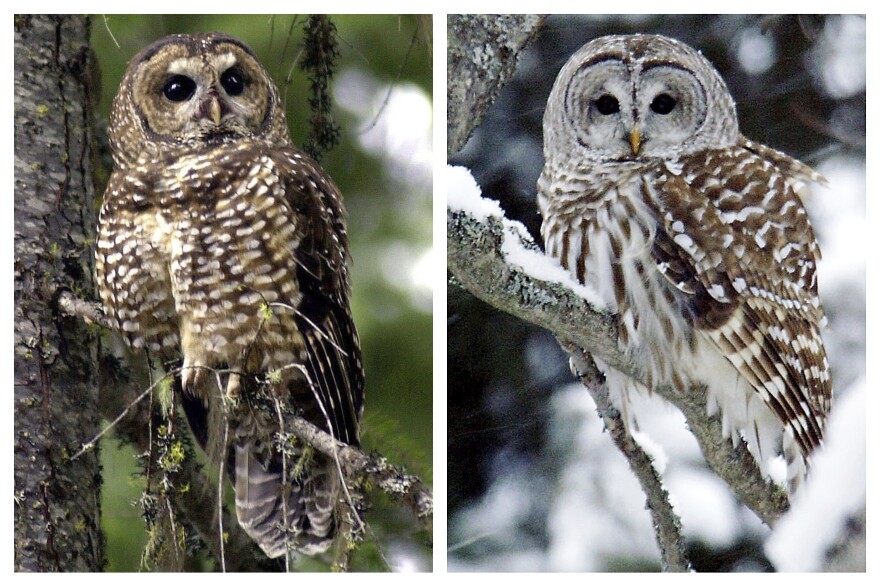A proposal by the U.S. Fish and Wildlife Service to kill roughly half a million barred owls to protect the spotted owl has conservationists and animal welfare advocates debating the moral issue of killing one species to protect another.
The proposal, published in November, garnered attention in recent days after dozens of wildlife protection and animal welfare organizations signed a letter opposing the plan.
In a March 25 letter responding to the proposal, a group of 75 organizations urged Secretary of the Interior Deb Haaland, to scrap what it calls a "reckless" plan. "Non-lethal management actions to protect spotted owls and their habitats should be made the priority action," it read.
But the USFWS says if no action is taken to cull the barred owl population, the northern spotted owl faces extinction.
The barred owl is crowding out its less aggressive relative, the northern spotted owl, in the Northwestern states, according to the USFWS. To ensure the survival of the northern spotted owl, a threatened species, the service is proposing the mass removal of over 470,000 barred owls across California, Washington and Oregon over a three-decade span. The proposed action will also help prevent declines in the California spotted owls, another species facing competition from barred owls, it said.
Animal rights advocates say the proposal is unsustainable
Wayne Pacelle, president of the Center for a Human Economy and its lobbying arm, Animal Wellness Action, who co-authored the letter, called the plan "unworkable." He says it's doubtful that the government's plan can be successfully executed across such a long time frame.
"If you don't do it dutifully and religiously every single year for 30 years, it has no chance of succeeding," Pacelle told NPR.
He argues that lethal management programs often succeed on closed ecosystems such as islands, but a management plan covering such a vast region wouldn't be as effective.
Cameron Barrows, a retired emeritus researcher at the Center for Conservation Biology at the University of California-Riverside, says that without a barred owl management strategy, spotted owls will disappear.
"If nothing is done to slow the encroachment of barred owls, you will lose spotted owls," he said. "There aren't a lot of choices left."
To him, the letter opposing the proposal effectively "means 'We'd rather have barred owls than spotted owls,' " he said.
A conservation organization in Washington also supports the proposed action. Birds Connect Seattle published a letter in January citing "preventing extinction" as one of its priorities.
"We are not celebrating this management plan in issuing our support," said Claire Catania, the executive director of Birds Connect Seattle. But, she says, her organization recognizes its necessity.
How far should people go to remedy a human-created problem?
Conservation experts who support the proposal say it's a difficult but necessary plan that will help solve a problem that humans helped create.
In 1990, the northern spotted owl was listed as threatened under the Endangered Species Act after environmentalists fought to protect the bird's habitat from the logging industry. The threatened designation also means the Fish and Wildlife Service is legally required to protect the northern spotted owl.
But around the same time, the barred owl, originally native to the Eastern U.S., emerged as another threat as it moved West, encroaching on spotted owl territory. Human-driven habitat destruction spurred the barred owls to expand across the country, Catania says. Their move west has since displaced their "smaller, less aggressive cousins," the spotted owl, according to Cornell Lab of Ornithology.
The spotted owl's habitat — old-growth forests — has become "very patchy" due to deforestation and are accessible to the more adaptable barred owl, says Barrows, the UC Riverside conservation researcher.
"This is a problem that humans have created. This wasn't nature happening on its own," Barrows said.
The Fish and Wildlife Service's proposal, outlined in a draft report assessing its environmental impact, is the latest attempt in a more than two-decade effort to save the spotted owl from extinction. A decade ago, the FWS began a four-year experiment to kill up to 3,600 barred owls in the northwest. According to Barrows, this strategy "slowed down but didn't stop" the barred owl invasion.
The public comment period for the proposal closed in January. A final proposal is expected in this spring or summer, NBC News reported.
Copyright 2024 NPR. To see more, visit https://www.npr.org.








